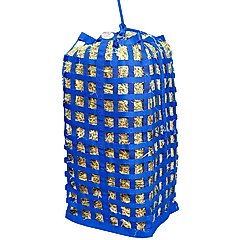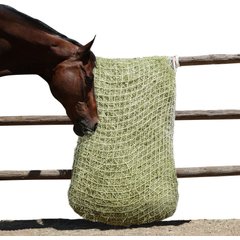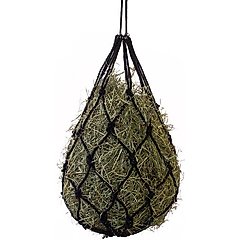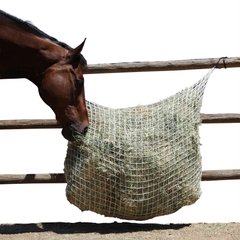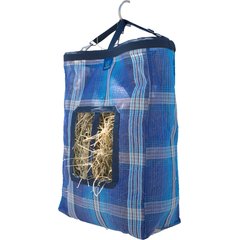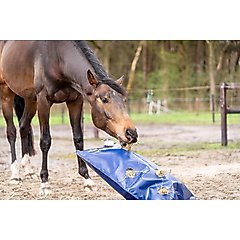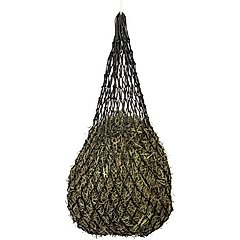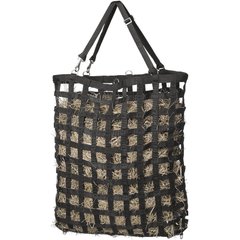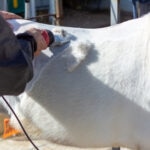Understanding Hay Nets for Horses: Types, Materials, and How To Choose
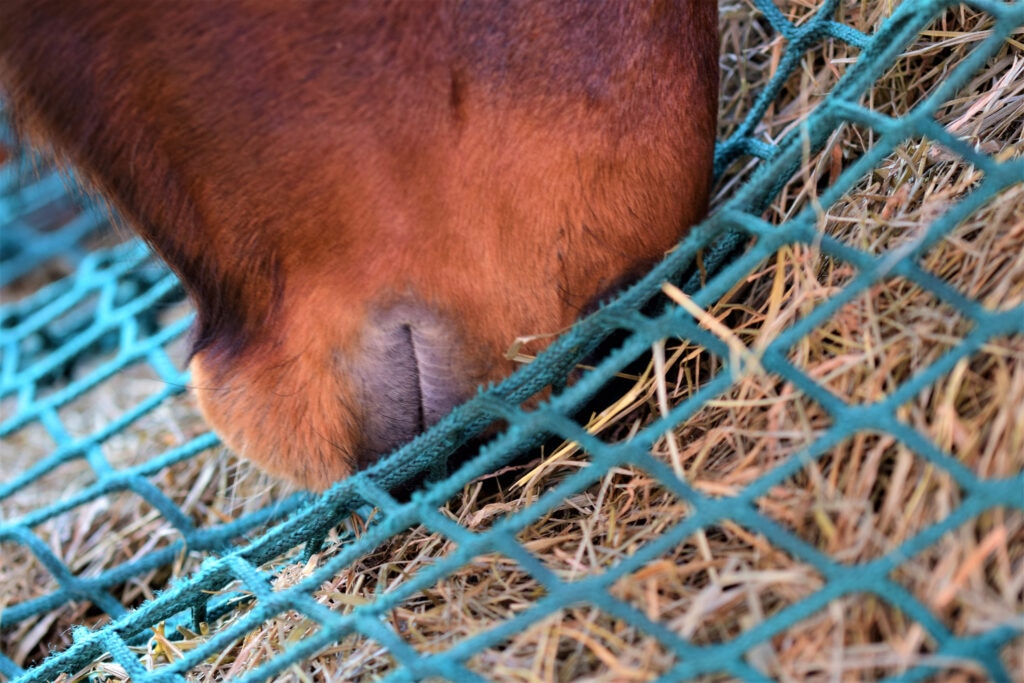
Photo by Anja Janssen/iStock/Getty Images Plus
A hay net is exactly what it sounds like: a net designed to hold hay for a horse. It can help control how much a horse eats, slow down fast eaters, and reduce waste—all while providing enrichment.
Here’s a look at the benefits of hay nets for horses, plus tips to help you choose the right one.
Key Takeaways
- Hay nets can be used by horses of all ages, offering clean forage in both stalls and pastures.
- Acting as slow feeders, hay nets can help prevent overeating—especially for overweight horses or those with metabolic issues.
- Hay nets are made of natural or synthetic materials and come in various designs and sizes.
Benefits of Using Horse Hay Nets
These are the main ways that horses benefit from a hay net:
Keeps Hay Off the Ground and Reduces Waste
Hay nets keep your horse’s hay off the ground, clean, and easy to access whenever they want to graze.
“While hay nets won’t eliminate waste completely, they have been shown to reduce the amount that gets left on the ground and uneaten,” says Nettie Liburt, PhD, PAS (professional animal scientist), who runs Liburt Equine Nutritional Consulting in Smithtown, New York.
Slows Down Eating and Controls Portions
Horses graze throughout the day. But if your horse eats too quickly or eats too much at a time, a hay net—particularly one with smaller holes—will slow them down.
Hay nets can also help with portion control, supporting healthy digestion and weight. They’re especially helpful for horses on diets, easy keepers (those who gain weight easily), and those with digestive problems.
Hay nets prolong the amount of time it takes to eat provided hay. By preventing your horse from being on an empty stomach, you can help reduce the risk of ulcers.
Liburt notes that horses shouldn’t go more than four hours without forage, as this increases the risk of gastric ulcers.
Provides Enrichment and Reduces Boredom
Foraging reduces stress and boredom, so you can place hay nets in a horse’s stall and pasture for environmental enrichment. This can help prevent problematic behaviors and stable vices like:
- Weaving
- Wood chewing
- Stall walking
- Wall kicking
- Pawing
- Cribbing/windsucking
What Are Some Common Types of Hay Nets?
Hay nets for horses are available in multiple designs, sizes, and materials. Consider the pros and cons of each type, along with your horse’s preferences and needs.
Traditional Hay Nets
Traditional hay nets are made of natural or synthetic materials and hold varying amounts of hay.
You can even find round bale hay nets and those that hold a rectangular bale of hay, like the Derby Originals X-Large Go-Around Patented Four-Sided Slow Feed Horse Hay Bale Bag, so you don’t need to refill them as often.
Recommended Product
The holes on hay nets are typically around 2 inches, like this one by Kensington, but you can also find those with larger holes up to 6 inches such as the Horze Cotton Horse Hay Net.
Recommended Products
Slow-Feed Hay Nets
Slow feeder hay nets have smaller holes to help horses eat more slowly. The size of the holes is typically 1 to 2 inches, as seen on the Kensington Protective Products Freedom Feeder, which can hold up to 50 pounds of hay.
Recommended Product
Make sure your horse can eat comfortably without too much difficulty. While it’s helpful to slow their eating, it shouldn’t make mealtime stressful.
Extra–Small Hole Hay Nets
Hay nets that have extra-small holes under 1 inch can provide more of a challenge and slow down your horse even more. These can be a good option for easy keepers and horses who need to have their calories restricted.
Again, if your horse struggles too much, they could become discouraged, so extra-small holes aren’t always appropriate.
Hay Bags
Instead of a netted design, a hay bag for horses, like the Kensington Protective Products 2 Flake Horse Hay Bag, will have one or more large holes on the side from which your horse can get their food.
Like nets, bags come in various sizes and are hung in place.
Recommended Product
If you want the best of both, you can buy a hay bag and hay net set, like this one from Majestic Ally.
Ground Hay Nets/Hay Balls/Hay Rollers
Ground hay nets or hay pillows, like the HayPlay Horse Slow-Feed Zip Bag, are placed on the ground. These allow your horse to eat in a natural posture.
Recommended Product
“Ground hay nets are best used secured inside a trough,” says Eleanor Kellon, VMD, veterinary nutritionist and owner of Equine Cushing’s and Insulin Resistance Group in Robesonia, Pennsylvania.
Hay balls, like the Horsemen’s Pride Jolly Hay Ball, can be used for snacking and enrichment. They won’t hold as much as nets or bags, but they can be hung in stalls.
Recommended Product
A hay roller is another type of equine slow feeder that provides enrichment. Compared to a hay ball, it can hold more hay and be placed on the ground.
Knotted and Knotless Hay Nets
You’ll also find knotted and knotless hay nets. Knotted hay nets, like the QiK Hay Net Horse Slow Feeder, have knots in each hole and may be more durable, while knotless nets, like the Tough-1 Slow Feed Web Hay Horse Feeder, may be more comfortable on a horse’s mouth.
Recommended Products
Hay Net Material Choices
Slow feeder hay nets and traditional hay nets are usually made of:
- Cotton: This natural material can be less harsh on your horse’s mouth but isn’t as durable. “Cotton nets are softer, but they may tear or break down faster if you have an aggressive eater,” says Liburt.
- Nylon and polypropylene: These tough, synthetic materials are weather-resistant and good for horses who easily wear out cotton hay nets. “Synthetic materials can sometimes be better for hay that needs to be soaked, as they’ll hold up a little better over the long term,” says Liburt.
How To Choose the Right Hay Net for Your Horse
With so many hay nets to choose from, how can you know which is best for your horse? Consider the following:
Your Horse’s Age, Dental Health, and Weight
Liburt recommends starting with your horse’s diet and health status—with the help of your veterinarian, who can tell you if your horse has metabolic concerns or needs to lose weight.
Calculate how much your horse needs to eat daily to choose the right-sized net that will hold enough hay.
Also, consider the size of the holes. If your horse is healthy and you want to reduce waste, a standard hay net is fine. But if your horse needs to eat slowly or shed pounds, go with one that has smaller holes.
Be sure the net doesn’t cause discomfort or injury. If your horse is older or has dental issues, choose soft, comfortable materials like cotton that won’t aggravate teeth and gums.
Hay Net Materials and Feeding Setting
You can use hay nets in stalls, pastures, and during travel, so determine where you’ll place them.
Whether you’re planning on hanging a hay net in a stall or using a ground hay net in the pasture, make sure it’s sturdy and durable, as well as easy to fill and clean.
If the hay net will be used outdoors, weather resistance is also important.
Behavior Factors
A hay net should help alleviate boredom and prevent behavioral issues, but if the holes are too small, it can have the opposite effect.
If your horse is having a hard time getting food from a net, they can become frustrated. In that case, switch to a net with bigger holes, or go with a hay bag that has one large opening.
Maintenance and Safety Tips for Horse Hay Nets
To make sure your horse is getting the best use out of their hay net, follow these tips:
- Regularly inspect a hay net to look for signs of damage, such as unraveling, rips, and tears. Once you start to notice the material wearing out, replace the net.
- Hay nets should also be cleaned thoroughly. Follow the manufacturer’s instructions for the specific type of hay net you’re using.
- Dr. Kellon recommends rinsing with hot water after each use before hanging the net to dry. “If using the net to soak hay, make sure it has a chance to dry out daily, so mold doesn’t form,” says Liburt.
- “If the horse is wearing a blanket or fly sheet, make sure buckles are turned in so they are less likely to catch on the net,” advises Liburt.
Nets should be hung around chest height and secured at both the top and bottom. If a net is too high, it can result in neck and back strain and respiratory issues. If too low, there’s a risk of the horse getting a hoof hung up in it, especially if they’re shod.
FAQs About Horse Hay Nets
Are hay nets good for horses?
Hay nets can be beneficial for horses, especially those who eat too quickly or need to manage their weight. The net should be made of durable materials, and it should be safe and comfortable for your horse to use.
Is one hay net enough for a horse overnight?
“When proper forage amounts are being fed overall, it should be OK to provide hay in a net for an overnight period,” says Liburt.
Properly space out the total daily amount of hay to determine how much to give your horse at night.
What size hay net do I need for horses?
“The major consideration is the hole size,” says Dr. Kellon.
For ponies or horses who eat quickly, she recommends holes that are 1–1.75 inches, while most full-size horses can use nets with holes that are 2.5–3 inches.
What is an alternative to hay nets for horses?
Alternatives to hay nets include equine hay bags, hay pillows, hay balls, hay rollers, and hay racks.
“Feeders that deliver a flake of hay at predetermined intervals are great for when you can’t be home to feed multiple times a day,” says Dr. Kellon.
What is the safest hay net?
The safest hay net is one that’s made of durable, non-toxic materials. It should stay securely in place once set at the proper height and shouldn’t pose a risk of harm (e.g., entanglement or a mouth injury) to your horse.
